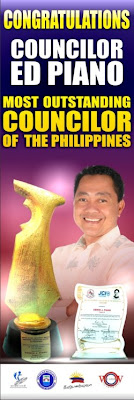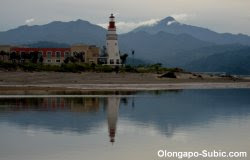Subic tree row: Group says reforestation a better option
SUBIC BAY FREE PORT—A nongovernment organization that recently completed an environmental study of the project site for the proposed $120-million Ocean 9 hotel-casino project here has concluded that replacing affected trees in the area would be a “wiser option” than relocating them elsewhere.
Pastor Malabrigo, a professor at the University of the Philippines in Los Baños (UPLB) and team leader of the environmental consultancy group Kanlungan Development Association of Innovators Inc., said the trees in the area are “mostly diseased.”
In this instance, he said, reforestation and other environment-protection activities should be undertaken by the project proponent Grand Utopia Inc., instead of spending too much for tree-balling and relocation.
Kanlungan, which was tapped by Grand Utopia to undertake the Initial Environmental Examination Report (IEER) for the hotel-casino project, is composed mostly of professors and experts from UP and holds office on the UPLB campus.
The group’s report, which was completed after a three-week study of the project site, debunked most of the arguments made by critics of the project, who said the development would sacrifice more than 300 trees.
Among the more significant findings by Kanlungan is the need to replace 161 “diseased trees,” even as the group recommended that 70 healthy trees be relocated, and 51 others be retained at the 1.9-hectare project site.
“People should look at the prospects of an 8-hectare reforested land versus the pitiful condition of the mostly defective trees in the project site,” Malabrigo said, as he argued for the reforestation option on Wednesday.
He said the project site, which served as a minigolf course during the US Navy days, is unsuitable for tree growth, with the concrete paving for the golf links causing the development of “very disturbed root systems.”
As a result, Malabrigo explained, trees in the area eventually developed various diseases such as rotting.
He added that most of the trees in the area “are very common species” like atis, langka and guava, among others. These “can be easily replaced with prime, even endangered, trees,” he said.
Malabrigo also stressed that his group did not recommend extensive tree-balling because this would cost from P100,000 to P200,000 per tree, depending on its size.
The better alternative would be reforestation, which costs around P70,000 per hectare per year, he said.
Moreover, “the very tedious process of balling and transplanting will subject the trees to a lot of stress,” Malabrigo pointed out.
“Unhealthy trees won’t be able to withstand this.”
“Rather than spending too much for relocation of trees whose survival is really uncertain, the SBMA [Subic Bay Metropolitan Authority] Ecology Center might as well ask the proponent to allocate resources for other environmental restoration and restoration activities,” he concluded.
In the course of its environmental examination, Kanlungan also said it has identified 235 trees and 47 palms in the project site, as opposed to 336 trees (including palm species) as inventoried by the SBMA Ecology Center.
Malabrigo said the discrepancy was due to the fact that the SBMA inventory individually counted each sprouting pole of the palm specie Palmera tree, when they should have been counted as individual clusters.
“Palms are not trees, and should be differentiated as such,” Malabrigo pointed out.
He said of the 48 tree species found in the area, only two—ipil and narra—are classified as “endangered.” The Manila Palm is also considered endangered.
Malabrigo, however, clarified that the term “endangered” means the population is threatened “in the wilds only” and does not necessarily mean that the species is on the brink of extinction.
This is true in the case of Manila palm, that is scarce in the wilds, but is commonly used in gardens and man-made landscapes.
For the Ocena 9 hotel-casino project, Malabrigo said the two ipil trees at the project site will not be affected by the project design and will be retained, along with five of the 18 Manila palms.
Among the 13 narra trees, which are found mostly at the periphery of the lot parcel, only one of these will have to be transplanted.
The rest, he said, “will find their way into urban landscaping” for the hotel-casino project.
He also clarified that the description of the project site as “densely stocked with trees” was inaccurate, since it has a tree density of less than three trees per 200 square meters.
This ratio falls short of the standard of one tree per two square meters, Malabrigo said.
To compensate for the trees that would have to be removed, Malabrigo said Grand Utopia would have to come up with replacement trees totaling 8,050, or 50 seedlings per one tree that will be replaced.
He said this ratio would be enough to reforest an 8-hectare area with the recommended spacing of three meters by three meters.
He added that the SBMA Ecology Center has already identified the Pastolan area at the east side of the Subic Bay Free Port as a viable reforestation area.
As to the contention by project critics that several trees in the area are “century-old,” Malabrigo said this cannot be ascertained without cutting the trees down and counting the annual rings.
But he noted that most of the trees in the area are saplings and poles with girths less than 10 centimeters in diameter.
The SBMA also said earlier that the project site, as confirmed by geological surveys, was reclaimed by the US Navy from swampland sometime in late 1950s or early 1960s. This, SBMA officials said, precludes the possibility that century-old trees could be found in the area. Written by Henry Empeño / Budiness Mirror Correspondent
Pastor Malabrigo, a professor at the University of the Philippines in Los Baños (UPLB) and team leader of the environmental consultancy group Kanlungan Development Association of Innovators Inc., said the trees in the area are “mostly diseased.”
In this instance, he said, reforestation and other environment-protection activities should be undertaken by the project proponent Grand Utopia Inc., instead of spending too much for tree-balling and relocation.
Kanlungan, which was tapped by Grand Utopia to undertake the Initial Environmental Examination Report (IEER) for the hotel-casino project, is composed mostly of professors and experts from UP and holds office on the UPLB campus.
The group’s report, which was completed after a three-week study of the project site, debunked most of the arguments made by critics of the project, who said the development would sacrifice more than 300 trees.
Among the more significant findings by Kanlungan is the need to replace 161 “diseased trees,” even as the group recommended that 70 healthy trees be relocated, and 51 others be retained at the 1.9-hectare project site.
“People should look at the prospects of an 8-hectare reforested land versus the pitiful condition of the mostly defective trees in the project site,” Malabrigo said, as he argued for the reforestation option on Wednesday.
He said the project site, which served as a minigolf course during the US Navy days, is unsuitable for tree growth, with the concrete paving for the golf links causing the development of “very disturbed root systems.”
As a result, Malabrigo explained, trees in the area eventually developed various diseases such as rotting.
He added that most of the trees in the area “are very common species” like atis, langka and guava, among others. These “can be easily replaced with prime, even endangered, trees,” he said.
Malabrigo also stressed that his group did not recommend extensive tree-balling because this would cost from P100,000 to P200,000 per tree, depending on its size.
The better alternative would be reforestation, which costs around P70,000 per hectare per year, he said.
Moreover, “the very tedious process of balling and transplanting will subject the trees to a lot of stress,” Malabrigo pointed out.
“Unhealthy trees won’t be able to withstand this.”
“Rather than spending too much for relocation of trees whose survival is really uncertain, the SBMA [Subic Bay Metropolitan Authority] Ecology Center might as well ask the proponent to allocate resources for other environmental restoration and restoration activities,” he concluded.
In the course of its environmental examination, Kanlungan also said it has identified 235 trees and 47 palms in the project site, as opposed to 336 trees (including palm species) as inventoried by the SBMA Ecology Center.
Malabrigo said the discrepancy was due to the fact that the SBMA inventory individually counted each sprouting pole of the palm specie Palmera tree, when they should have been counted as individual clusters.
“Palms are not trees, and should be differentiated as such,” Malabrigo pointed out.
He said of the 48 tree species found in the area, only two—ipil and narra—are classified as “endangered.” The Manila Palm is also considered endangered.
Malabrigo, however, clarified that the term “endangered” means the population is threatened “in the wilds only” and does not necessarily mean that the species is on the brink of extinction.
This is true in the case of Manila palm, that is scarce in the wilds, but is commonly used in gardens and man-made landscapes.
For the Ocena 9 hotel-casino project, Malabrigo said the two ipil trees at the project site will not be affected by the project design and will be retained, along with five of the 18 Manila palms.
Among the 13 narra trees, which are found mostly at the periphery of the lot parcel, only one of these will have to be transplanted.
The rest, he said, “will find their way into urban landscaping” for the hotel-casino project.
He also clarified that the description of the project site as “densely stocked with trees” was inaccurate, since it has a tree density of less than three trees per 200 square meters.
This ratio falls short of the standard of one tree per two square meters, Malabrigo said.
To compensate for the trees that would have to be removed, Malabrigo said Grand Utopia would have to come up with replacement trees totaling 8,050, or 50 seedlings per one tree that will be replaced.
He said this ratio would be enough to reforest an 8-hectare area with the recommended spacing of three meters by three meters.
He added that the SBMA Ecology Center has already identified the Pastolan area at the east side of the Subic Bay Free Port as a viable reforestation area.
As to the contention by project critics that several trees in the area are “century-old,” Malabrigo said this cannot be ascertained without cutting the trees down and counting the annual rings.
But he noted that most of the trees in the area are saplings and poles with girths less than 10 centimeters in diameter.
The SBMA also said earlier that the project site, as confirmed by geological surveys, was reclaimed by the US Navy from swampland sometime in late 1950s or early 1960s. This, SBMA officials said, precludes the possibility that century-old trees could be found in the area. Written by Henry Empeño / Budiness Mirror Correspondent







0 Comments:
Post a Comment
<< Home